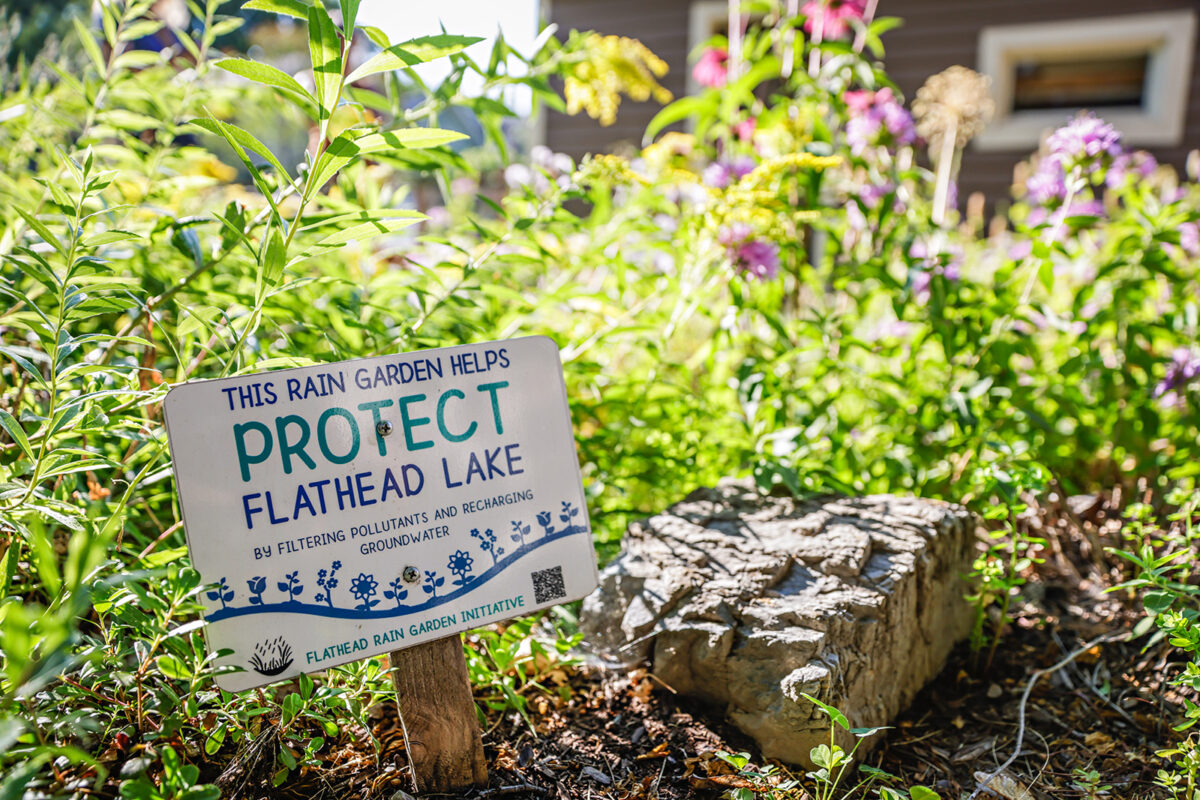Local Agencies Educate Residents About Rain Garden Benefits
The Flathead Rain Garden Initiative launched three years ago to prevent pollutants from entering storm drains; officials will host a rain garden tour on Wednesday evening
By Maggie Dresser
Three years ago, when Shannon Freix struggled to keep the grass alive in a triangular-shaped portion of her backyard, she attended a Flathead Rain Garden Initiative (FRGI) workshop hosted by local agencies to brainstorm an alternative use for the patch.
At the workshop, she learned about rain gardens, which use native plants and are built in a depression with a design meant to capture rain and prevent runoff, which is instead filtered through the soil and helps reduce erosion.
Tired of wasting time watering her dying grass, Freix began working with FRGI partners who helped her replace the dead patch in her yard with a rain garden. She dug up the old sod and planted beebalm, columbine, echinacea, goldenrod and a variety of other native flowers.
Freix planted flowers in need of moisture in the center of the garden, which absorbs the most water, and drought-tolerant starts around the perimeter. Situated next to her shed, where rain runs off the roof, the plants absorbed the rain instead of the runoff heading into storm drains.
Three years later, the native plants exploded and pollinators like bees now frequent her backyard.
“It’s really cool to see,” Freix said.

Freix was one of the first participants of the FRGI, which is comprised of the Western Montana Conservation Commission, the Flathead Conservation District, the Center for Native Plants and the City of Kalispell. The program was launched in 2020 to incentivize planting rain gardens and educate residents about stormwater pollution.
Katie Lynch-Dombroski of the Western Montana Conservation Commission (formerly the Flathead Basin Commission) says that since storm water pollution has no point source, it’s difficult to regulate.
“Our landscape is littered with pollutants like pet waste, car oil, grease and fertilizer, so when it rains, those pollutants are carried into drains and those get deposited into rivers and lakes,” Lynch-Dombroski said. “It doesn’t go to a wastewater treatment plant.”
Since rain gardens are bowl-shaped, storm water is absorbed in their center where it becomes groundwater instead of storm water, which reduces flooding and prevents moisture from going down storm drains.
Rain gardens are set up in “zones,” with Zone A in a depression that contains plants, like blue-eyed grass, that are temporarily inundated with water after a rain or snow event. The next zones move outward and gradually become more drought-tolerant, including balsamroot, lupines and blue elderberry shrubs.
Emilie Henry of the Western Montana Conservation Commission said that in the last three years since the program launched, agencies have helped build 18 rain gardens across Flathead County. Grants and labor were initially offered to help residents get started.
“We’ve had quite a few really engaged participants and it’s been a great experience to interact with the residents and provide them the means for taking action,” Henry said. “The homeowners really enjoy them, and some are really interested in providing pollinator habitat.”

As a program developer for the Center for Sustainability at Whitefish High School, Randy Hohf was naturally interested in the FRGI and he built a rain garden in the program’s pilot year.
Officials with the FRGI provided him funding and labor to help him build a 30-foot-by-15-foot garden next to his home in Kalispell where he planted spirea, honeysuckle, goldenrod, wild onion and black elderberry.
“It looks like a jungle now,” Hohf said. “Everything is so full that you can’t even see the ground anymore,”
Hohf said the garden requires no maintenance now that it’s established. He only waters during the summer’s hottest days and he enjoys seeing the same native plants in his yard that he sees while he’s climbing mountains in Glacier National Park.
“It gives me a piece of the mountains,” Hohf said. “It’s just beautiful and I love the low maintenance.”
The FRGI will host a rain garden walking tour on Wednesday, July 12 from 6 p.m. to 8 p.m. in Kalispell. The tour will meet at the Hockaday Museum of Art lawn where participants will walk to three rain gardens and hear their homeowner’s stories.
To register, contact the Flathead Conservation District at (406) 752-4220 or email [email protected].